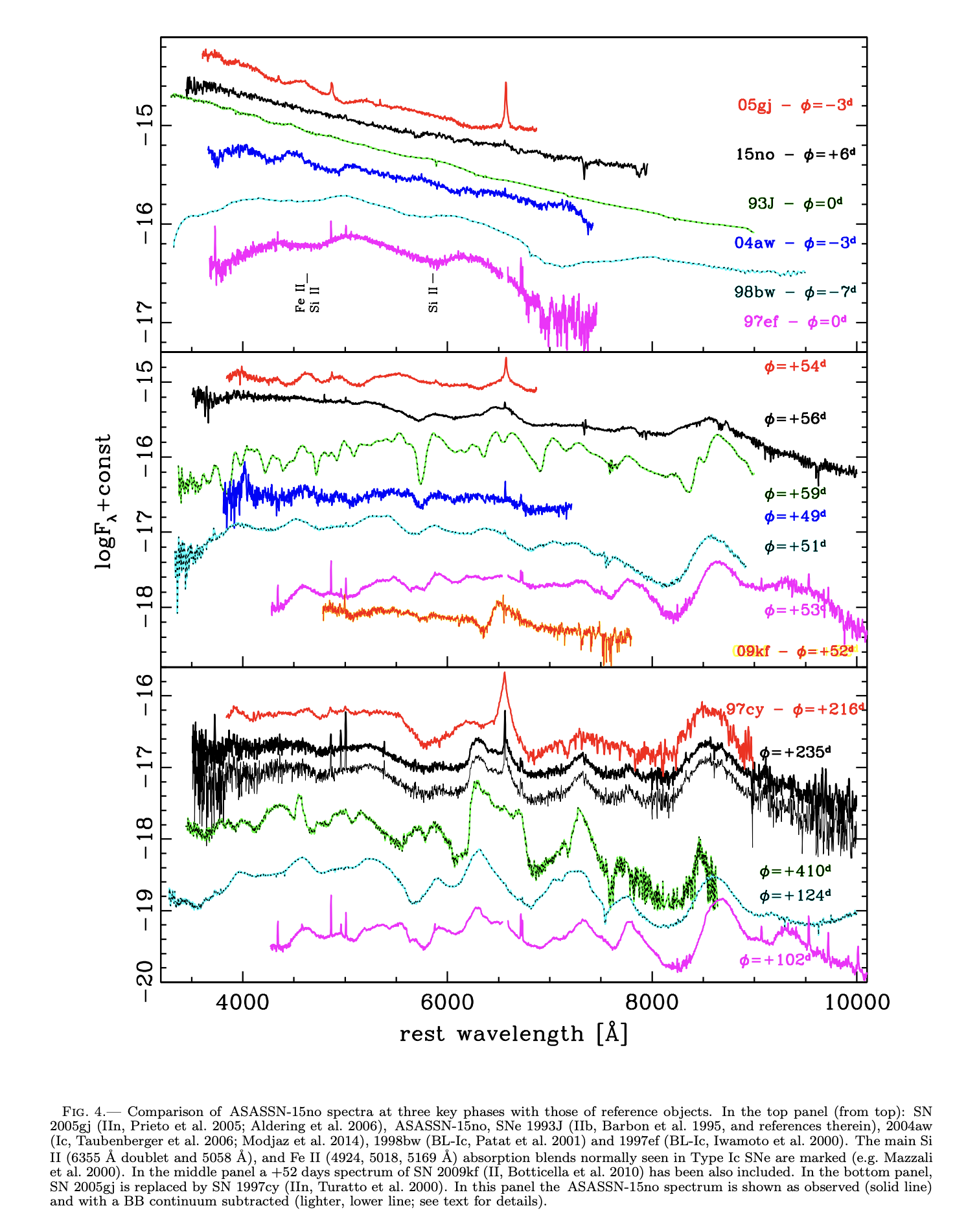Padova-Asiago Supernova Group
Highlights
ASASSN-15no: the Supernova that plays hide-and-seek
Benetti, S. et al. 2018, MNRAS 476,261 (link to pdf)
We report the results of our follow-up campaign of the peculiar supernova ASASSN-15no, based on optical data covering ~300 days of its evolution. Initially the spectra show a pure blackbody continuum. After few days, the HeI 5876 A transition appears with a P-Cygni profile and an expansion velocity of about 8700 km/s. Fifty days after maximum, the spectrum shows signs typically seen in interacting supernovae. A broad (FWHM~8000 km/s) Halpha becomes more prominent with time until ~150 days after maximum and quickly declines later on. At these phases Halpha starts to show an intermediate component, which together with the blue pseudo-continuum are clues that the ejecta begin to interact with the CSM. The spectra at the latest phases look very similar to the nebular spectra of stripped-envelope SNe. The early part (the first 40 days after maximum) of the bolometric curve, which peaks at a luminosity intermediate between normal and superluminous supernovae, is well reproduced by a model in which the energy budget is essentially coming from ejecta recombination and 56Ni decay. From the model we infer a mass of the ejecta Mej = 2.6 Msun; an initial radius of the photosphere R0 = 2.1 x 10^14 cm; and an explosion energy Eexpl = 0.8 x 10^51 erg. A possible scenario involves a massive and extended H-poor shell lost by the progenitor star a few years before explosion. The shell is hit, heated and accelerated by the supernova ejecta. The accelerated shell+ejecta rapidly dilutes, unveiling the unperturbed supernova spectrum below. The outer ejecta start to interact with a H-poor external CSM lost by the progenitor system about 9 -- 90 years before the explosion. 109
Benetti, S. et al. 2018, MNRAS 476,261 (link to pdf)
We report the results of our follow-up campaign of the peculiar supernova ASASSN-15no, based on optical data covering ~300 days of its evolution. Initially the spectra show a pure blackbody continuum. After few days, the HeI 5876 A transition appears with a P-Cygni profile and an expansion velocity of about 8700 km/s. Fifty days after maximum, the spectrum shows signs typically seen in interacting supernovae. A broad (FWHM~8000 km/s) Halpha becomes more prominent with time until ~150 days after maximum and quickly declines later on. At these phases Halpha starts to show an intermediate component, which together with the blue pseudo-continuum are clues that the ejecta begin to interact with the CSM. The spectra at the latest phases look very similar to the nebular spectra of stripped-envelope SNe. The early part (the first 40 days after maximum) of the bolometric curve, which peaks at a luminosity intermediate between normal and superluminous supernovae, is well reproduced by a model in which the energy budget is essentially coming from ejecta recombination and 56Ni decay. From the model we infer a mass of the ejecta Mej = 2.6 Msun; an initial radius of the photosphere R0 = 2.1 x 10^14 cm; and an explosion energy Eexpl = 0.8 x 10^51 erg. A possible scenario involves a massive and extended H-poor shell lost by the progenitor star a few years before explosion. The shell is hit, heated and accelerated by the supernova ejecta. The accelerated shell+ejecta rapidly dilutes, unveiling the unperturbed supernova spectrum below. The outer ejecta start to interact with a H-poor external CSM lost by the progenitor system about 9 -- 90 years before the explosion. 109
